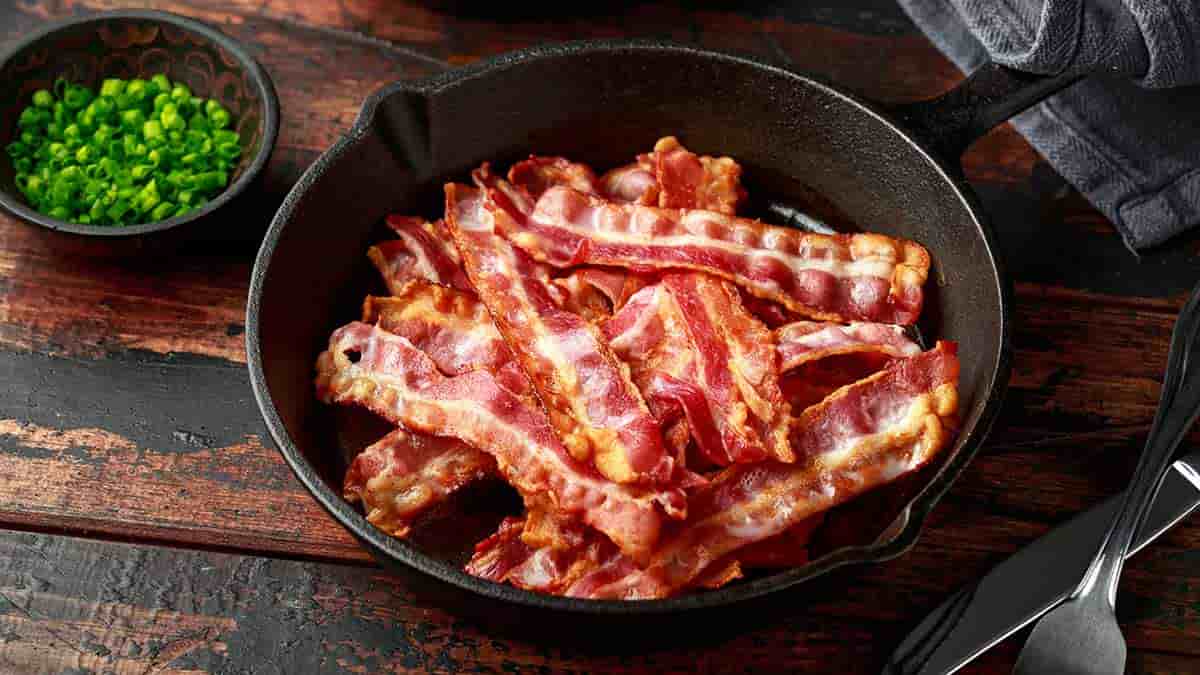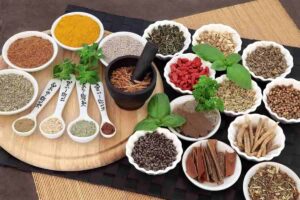Bacon is the ultimate meat addition for many different foods. Some people think that you could put bacon on almost anything. But the nutrition facts about bacon are a little less appealing.
Bacon is a meat product that has massive amounts of protein and fat along with several different preservatives and a significant amount of sodium, making it a very unhealthy food.
There is no doubt that bacon tastes great. The fatty grease and sodium are a lovely addition to many meals. Some people even eat it on its own. But the nutritional facts about bacon are mixed, and too much bacon might be very unhealthy. Read on for more information about all of the nutrition facts of bacon.
Article Contents
What is Bacon?
Bacon is best known as a type of salt-cured pork typically eaten on its own as a side dish or used as an ingredient in sandwiches, salads, pasta dishes, and more. Different types of bacon get made from various cuts of pork. Most commonly, bacon gets made from pork. However, you can also find similar products like turkey bacon and, more recently, vegetarian bacon.
Bacon is something everyone wants to indulge in. Like most meats, bacon is very nutritious, containing high-quality animal protein, vitamins, and minerals. For most people, the flavor of bacon makes it a favorite breakfast side to becoming essential in many fast-food restaurants. It has gained popularity with increased interest in low-carb and high protein diets such as Keto.
Bacon is a delicious and nutritious meat that comes in many varieties. Understanding the different varieties of bacon will open up unlimited culinary possibilities. Read on to learn more about the different types of bacon and the health considerations of eating bacon.
Types of Bacon
Bacon comes in many varieties depending on which part of the pig it comes from. Many sorts of bacon have a regional origin and popularity. More recently, many different types of smoked meats and plants fall under the name “bacon.”
Bacon has nutritional value and flavor. However, understanding the effect of how bacon is processed and its effect on your long-term health should get considered.
Below is a list that helps explain the differences between the various types of bacon.
- Streaky Bacon: This is one of the most common types of bacon, labeled as “Bacon” and also called “Side Bacon,” which indicates that it originates from the pig’s side (or belly) and is rich in fat, making it mouth-watering and crispy after searing.
- Slab Bacon: This is a smoked pork belly that can get sliced into bacon strips, cubes, thick bacon, or thin bacon.
- Jowl Bacon comes from a small part of the meat of the pig’s cheek. The jowl is the most all-around cut of bacon since it possesses all the desirable features. Rich and tender with a slice of perfect meat and fat ratio, Jowl Bacon includes all the desirable features. When cooked, the fat melts and creates a fantastic fat essence which makes it crispy and bold in flavor. Jowl bacon is a slice of essential bacon in the southern part of the United States, a staple of many soul foods. Outside the United States, it has a non-smoked and dry-cured version called guanciale.
- Back Bacon: Back bacon is more common in the United Kingdom and Canada comes from pork found in the middle back of pigs, a leaner part with a mild flavor. Due to the leanness, it is meatier with a higher meat-to-fat ratio, making it chewy with a thicker texture. Canadian Bacon is a kind of back bacon from Toronto. Typically, Canadian Bacon is fully cooked and ready to eat.
- Ham Bacon: This is another lean type of bacon taken from the back, well-exercised leg of a pig. Therefore, it gets packed with flavor, but the texture is somewhat firm. This part of the pork is also used for ham but treated as bacon by some.
- Thick-cut Bacon: One of the most popular, this is generally 50% thicker than the version of Streaky Bacon. The thicker the bacon, the less crispy the texture but offers a meatier bite.
- Pancetta: This traditional bacon gets used in many dishes. Pancetta is an Italian version of bacon made without smoking, from pork belly and cured with salt and black pepper. This seasoning gives Pancetta a unique rich flavor that is different from ordinary bacon. Producers will curl the meat in a tight roll and wrap it with a casing to maintain the shape that can be thinly sliced.
- Lardon: Also known as Lardoon or pork fat, is bacon strips or cubes. Lardon can get prepared from different cuts, including pork belly and fatback. To give foods an extra kick of flavor, Lardon gets used by French Chefs for making dishes such as tartes flambées and beef bourguignon. Authentic Lardon cannot get smoked; it must be cured with salt.
- Sugar-Free Bacon: For those who are health conscious, this bacon is for those who want to eat less sugar due to health reasons or those who are on a ketogenic diet.
- Beef Bacon: From cows, this is bacon made of beef made from the meat source of short ribs, hanger steak, and skirt steak. These portions of meat are pretty fatty, and hence it is suitable to produce bacon. It has a robust beefy flavor that pork bacon does not have.
- Turkey Bacon: A lower fat alternative to traditional bacon, a recent addition for those who do not eat pork. Turkey meat is prepared like pork bacon but is lean and low in calories. The turkey is first seasoned then chopped in a way where it can resemble the appearance of bacon strips.
- Vegetarian Bacon: Veggie Bacon or Vacon is bacon made from vegetables that are typically low-fat and cholesterol-free but high in protein and fiber. The common ingredients to make Vegetarian Bacon are coconut, tempeh, shiitake mushrooms, seitan, and more. These types of bacon are the best way for vegetarians and vegans to enjoy bacon, just as carnivores enjoy it daily.
Bacon Health Concerns
Bacon has nutritional value, and for many, the taste of bacon is irresistible. Unfortunately, the process of making bacon and bacon’s high-fat contents is worth careful consideration for those who take their health seriously. The additives used to make bacon have gotten shown to be harmful to your health, and a diet high in certain fats has gotten shown to contribute to health problems.
Making bacon goes through the curing process that uses additives to preserve meat, kill bacteria, and boost flavor and color. The curing process for bacon puts bacon in the “processed meat” category, which uses nitrites — a type of salt — and nitrates.
Bacon was disgraced in October 2015, when the International Agency for Research on Cancer, part of the World Health Organization, named processed meat a “group 1 carcinogen,” finding that there’s enough evidence that eating these foods can cause colon or stomach cancer. The problem with these additives is that high-heat cooking causes them to form compounds called nitrosamines, known carcinogens.
The fat content in bacon contributes to the mouth-watering flavor that makes it so enjoyable. With many health professionals convinced that a high intake of saturated fat is a significant cause of heart disease, the 40% saturated fat content of bacon can be a health problem for some. You should know about the high-fat content of bacon, keeping your typical serving size is small.
Is it Bad to Eat Bacon Every Day?
Along with being a lump of unhealthy processed meat, the high-fat content of bacon could cause you to pack on some pesky unhealthy extra pounds. If you consume more calories from food and beverages than you burn through exercise and daily life activities, you’ll gain weight. With a gram of fat contributing nine calories per gram compared to four each for carbohydrates and protein, fats are calorie-dense foods.
With saturated fat making up a large part of the nutritional profile of bacon, you should understand how this may affect your health. Saturated fat contributes to an increased risk of chronic health problems such as diabetes and unhealthy weight gain.
Health Effects of Eating Bacon
Overeating saturated fat can also raise your cholesterol levels, which increases your risk of heart disease. Bacon is high in total fat, but a large portion of that is saturated. To prevent health problems, you should keep your saturated fat intake to 10 percent or less of your total caloric intake, but eating bacon can make it challenging to stay within that limit.
One slice of bacon contains 3.18 grams of total fat, 1 gram of which is saturated. A serving size for bacon is usually three or four slices, which means that you consume about one-fifth of your daily saturated fat limit for the entire day.
Eating large amounts of bacon every day won’t be good for your waistline and your overall health. Taking the ‘eating in moderation’ approach with daily consumption of bacon is advised. Eating smaller portions of bacon and using bacon bits to provide the flavor desired in salads and sandwiches can help strike a balance between taste and calorie intake.
Most Popular Way to Cook Bacon
From stovetop to oven to microwave, each method of cooking bacon has its pros and cons. Ultimately, circumstances such as how you prefer bacon crispy or chewy or how much you need to cook may determine which method is best.
Skillet
The classic skillet method is tried and valid for cooking six to eight pieces of bacon. You start by taking the bacon from the fridge 15 to 20 minutes before cooking. At room temperature, bacon cooks up better (just like steak).
Cook your bacon over medium heat — again, suitable for even rendering. Don’t preheat the skillet and lay out the bacon strips without overlapping in a cold pan. Not preheating the skillet helps the fat render slowly, making for consistently cooked strips. Turn the strips as needed until they reach the desired crispness, typically about 8 to 12 minutes. Drain well on a paper-towel-lined platter.
Oven
Cooking bacon in the oven is your best go-to method when you need bacon for a big group and don’t want to bother making multiple batches. Plus, there’s no turning, and cleanup is simple.
To start, you’ll line a baking sheet with foil or parchment paper and lay out as many bacon strips as will fit snugly without overlapping. Place the baking sheet in a cold oven. Then heat the oven to 400 degrees F and bake to desired crispness, usually between 25 to 35 minutes. Drain the cooked bacon well on a paper-towel-lined platter.
Microwave
When you need only a few bacon pieces for a burger or BLT, cooking bacon in the microwave is a quick and easy way to go.
Start with lining a microwave-safe plate with two layers of paper towels. Next, lay out the bacon strips without overlapping and cover them with two more paper towels.
Cook in the microwave on high to desired crispness. Approximately 4 to 6 minutes is best. Since the strips cook on paper towels, no draining is necessary.
In Conclusion
There are many varieties of bacon, and they all offer you endless choices for enjoyment. The flavor of bacon is legendary. However, the nutrition of bacon is known for causing health problems.
Now that you know the harmful effects of additives and the high-fat content of bacon, it should be clear that you should limit how much and how often you eat bacon. There are simple, easy ways to cook bacon just how you like it when cooking for yourself or a crowd.




